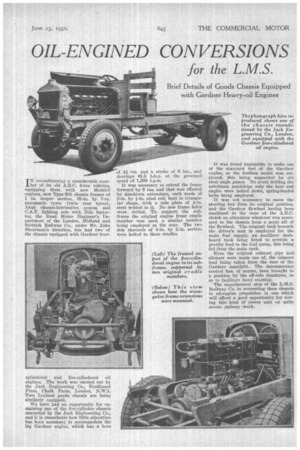OIL-ENGINED CONVERSIONS
Page 49

If you've noticed an error in this article please click here to report it so we can fix it.
for the L.M.S.
IN reconditioning a considerable number of its old A.E.C. 4-ton vehicles, equipping them with new Model-5 engines, new Type-501 chassis frames. of 1 in. deeper section, 38-in. by 7-in. pneumatic tyres (twin rear tyres), Alcyl chassis-lubrication system and C.A.V. lighting sets with Nife batteries, the Road Motor Engineer's Department of the London, Midland and Scottish Railway Co., under Mr. John Shearman's direction, has had two of the chassis equipped with Gardner four
cylindered and five-cylindered oil engines. The work was carried out by the Jack Engineering Co., Ferdinand Place, Chalk Farm, London, N.W.1. Two Leyland goods chassis are being similarly equipped.
We have had an opportunity for examining one of the five-cylinder chassis converted by the Jack Engineering Co., and it is remarkable how little alteration has been necessary to accommodate the big Gardner engine, which has , a bore
of 41 ins, and a stroke of 6 ins., and develops 61.5 h.h.p. at the governed speed of 1,300 r.p.m.
It was necessary to extend the frame forward by 9 ins, and that was effected by dumbiron extensions, each made of 2-in, by i-in. steel rod, bent to triangular shape, with a side plate of Fin. steel welded to it. No new frame holes ' were drilled. To support the subframe the original engine front cradle member was used, a similar member being employed at the rear. The two side channels of 4-in. by 2-in. section were bolted to these cradles.
• It was found impossible to make use of the standard feet of the Gardner engine, so the footless model was employed, this being supported by six steel angle plates. To avoid drilling the sub-frame amidships only the four end angles were bolted down, spring-loaded bolts being employed.
It was not necessary to move the steering box from its original position, and the Gardner flywheel having been machined to the cone of the A.E.C. clutch no alteration whatever was necessary to the chassis from a point aft of the flywheel. The original tank beneath the driver's seat is employed for the main fuel supply, an auxiliary dashboard tank beite=, fitted to provide a gravity feed to the fuel pump, this being fed from the main tank.
Even the original exhaust pipe and silencer were made use of, the exhaust lead being taken from the rear of the Gardner manifold. The decompressor control has, of course, been brought to a position by the off-side dumbiron, so as to facilitate hand starting.
The experimental step of the L.M.S. Railway Co. in converting these chassis to oil-engine propulsion is one which will afford a good opportunity for testing this kind of power unit on quite severe railway work.




























































































